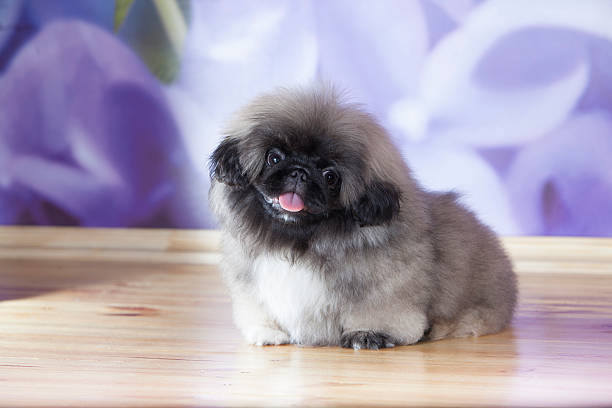Pekingese

Breed History:
The Pekingese is an ancient toy breed that originated in China over 2,000 years ago, developed as a royal companion for Chinese emperors and nobility. Highly esteemed in the imperial courts, Pekingese dogs were regarded as sacred and often lived in palaces. According to legend, the breed was created when a lion fell in love with a marmoset and was transformed into a small dog by the Buddha.
For centuries, the Pekingese remained exclusive to Chinese royalty until the mid-19th century, when British forces brought a few dogs to England after the Second Opium War. The breed quickly gained popularity in the West for its regal appearance, confident personality, and rich cultural heritage.
|
Gender |
Height |
Weight |
|
Male |
15–23 cm |
3.2–6.4 kg |
|
Female |
15–23 cm |
3.2–6.4 kg |
Size – Toy
Life Expectancy: 12–14 years

Breed Appearance:
The Pekingese is a compact, low-slung dog with a long, flowing double coat and a lion-like mane around the neck and shoulders. Its large, dark eyes, flat face, and prominent black nose give it a distinctive expression of dignity and intelligence. The breed has a heavy front and lighter hindquarters, creating a unique rolling gait.
The coat comes in a wide variety of colours, including gold, sable, cream, black, red, and white, often with a black mask. Feathers on the ears, tail, and legs add to its ornate appearance. Despite its small size, the Pekingese carries itself with great confidence and dignity.
Breed Type – Companion/Family:
Bred primarily as a lapdog and companion, the Pekingese is deeply affectionate and loyal to its family. It forms strong bonds with its owner and often becomes particularly attached to one person. While affectionate with family, it can be aloof and reserved with strangers, reflecting its aristocratic heritage.
The breed is calm and independent, but can be quite bold and courageous for its size. While not ideal for very young children due to its small and fragile stature, it does well in adult or gentle households and thrives on human companionship.

Training:
The Pekingese is intelligent but can be stubborn and independent, making training a test of patience and persistence. It does not respond well to harsh corrections but learns best through positive reinforcement, praise, and rewards.
Early socialisation is important to help the dog become well-adjusted and more open to strangers and other animals. Consistent boundaries and gentle handling will encourage obedience while respecting the breed’s proud temperament.
Health & Care:
While generally healthy, the Pekingese is prone to several health issues due to its brachycephalic (flat-faced) anatomy. Common health concerns include:
-
Brachycephalic airway syndrome
-
Eye problems (corneal ulcers, dry eye)
-
Intervertebral disc disease (IVDD)
-
Heart conditions
-
Skin fold infections
Due to their facial structure, they are sensitive to heat and can overheat easily. Regular veterinary checkups, weight management, and avoiding overexertion, especially in warm weather, are crucial for this breed.

Living Conditions:
The Pekingese adapts well to apartment or indoor living and does not require a yard, though it appreciates a secure area for short walks and exploration. It enjoys quiet, calm households and prefers to lounge near its family.
Because of its sensitivity to temperature extremes, particularly heat, it should be kept in a temperature-controlled environment. This breed is not suited for roughhousing or excessive handling and prefers a peaceful, predictable routine.
Exercise:
The Pekingese has low to moderate exercise needs. Short daily walks and indoor playtime are sufficient to keep it healthy and mentally stimulated. It is not an overly active breed and enjoys lounging or being carried.
Care must be taken to avoid vigorous activity in warm weather, as the breed is prone to overheating due to its flat face and dense coat. Gentle activities and short walks during cooler parts of the day are ideal.
Grooming:
The Pekingese requires regular and meticulous grooming to maintain its luxurious coat. Key grooming tasks include:
-
Daily brushing to prevent tangles and mats
-
Weekly cleaning of facial folds to prevent infection
-
Regular bathing every 3–4 weeks with a gentle shampoo
-
Nail trimming and ear cleaning as needed
-
Frequent eye care to manage discharge and prevent irritation
Due to its dense coat and thick undercoat, professional grooming every few months can help manage coat health.

Advantages:
-
Regal and affectionate companion with a loyal personality
-
Adaptable to small living spaces and calm indoor lifestyles
-
Naturally dignified and composed, with moderate energy needs
-
Quiet and generally not overly vocal
-
Excellent lapdog with a deep history and cultural significance
-
Independent yet deeply devoted to its chosen family member
Disadvantages:
-
Requires daily grooming and coat maintenance
-
Can be stubborn and resistant to training without patience
-
Not suited to rough play or homes with very young children
-
Sensitive to heat due to brachycephalic anatomy
-
May develop breathing or eye problems
-
Can be reserved or aloof with strangers without early socialization

